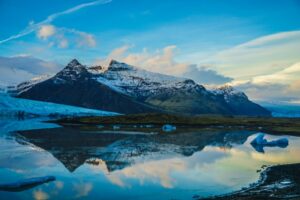“Glacial lake failure” causing tsunami inland
Due to the effects of global warming, Arctic ice and permafrost in high-latitude regions continue to melt, or because of this,
Apart from the buildings that were standing and the ice in the Arctic, for example, all the ice and snow in Antarctica melted into the sea.
If it flowed in, the sea level would rise by 65 meters, and after this passed, a lot of land around the world would be
I’ve often heard terrible stories about sinking into the ocean and possibly happening in the near future.
There are other natural disasters that occur on a level beyond human comprehension.
“Glaciers” are high-altitude mountainous areas and high-latitude areas where snow falls and freezes, and soon after thawing.
It is a block of ice that has accumulated and accumulated and been compressed over tens of thousands of years.
This is called a “glacier” because it flows from 10 meters to several hundred meters in some places.
There is.
The question of why individual glaciers move is a question that has bothered physicists for a long time.
In mountainous areas, it is convincing to slide down the slopes, but the vast “ice sheets” of the plains (glacial
It is thought that the ice block may move due to deformation due to its own weight.
It seems.
In addition, glaciers with relatively high temperatures at the bottom and thin water membranes slide on the membrane.
It is seen.
By the way, the “glacier” can create a lake.
This may be easy to imagine, isn’t it?
Deep valleys are carved after glaciers in mountainous areas spend tens of thousands of years carving down the slopes.
Snowmelt and rainwater accumulate there and become a lake. In some cases, it can be dammed by the glacier itself.
It is.
These natural dam lakes are called “glacial lakes.”
Glacial lakes sometimes overflow and cause major floods.
The scale and frequency vary depending on geography, but in Alaska, for example, glacial lake outburst floods occur almost every year.
It seems to be awake.
The runway of the nearby airport is flooded every time.
In Iceland, a volcanic eruption in 1996 triggered a glacier collapse that flooded the lake.
The amount of water when it collapsed reached 45,000 cubic meters per second, destroying the national highway and causing serious damage.
Brought.
Eventually, the amount of water that flowed around this area exceeded the flow rate of the Mississippi River.
When a glacial lake bursts, like a dam breaks, a large amount of water will hit from high on land.
The enormity of its power is unimaginable.
Nepal has also been hit by major floods caused by glacial lake outbursts for several decades, but in 1985
The Digu Tso Glacial Lake Collapse sparked a detailed study of glacial lake outburst flooding.
According to a survey report conducted in 1996 by the Department of Water and Energy Research in Nepal, in addition to Digu Tso Lake, it was located at an altitude of 4,100
Four glacial lakes above m are at risk of flooding.
In addition, a recent study by the International Center for Integrated Mountain Development and the United Nations Environment Programme (UNEP) found that in Nepal
Not only that, but there is also a dangerous glacial lake in neighboring Tibet, and if it breaks, Nepal will be substantial.
We expect it to reach.
Just the other day, the academic journal Nature Communications reported that the potential impact of glacial lake failure
A specialized research paper was published.
According to the report, the flooding caused by the collapse of a glacial lake would be like a “tsunami” inland, and the damage it would cause would be so enormous that it cannot be overstated.
Partly due to global warming, the danger has never been higher as glaciers melt rapidly.
If floods occur in the future, as many as 15 million people living within 48 kilometers of glacial lakes could be engulfed around the world, more than half of which are concentrated in four countries: India, Pakistan, Peru and China.
As for North America and the European Alps, the number of people living around glacial lakes is small, so human casualties are not expected to be so high.
Even in Japan, if a dam collapses due to torrential rain, it will cause considerable damage, but there is nothing we can do about it because of the uncontrollable nature.
At the very least, in order to slow global warming, is there any other way but to cooperate with decarbonization efforts?

By Admin|2023-03-02|2023,News Release|
